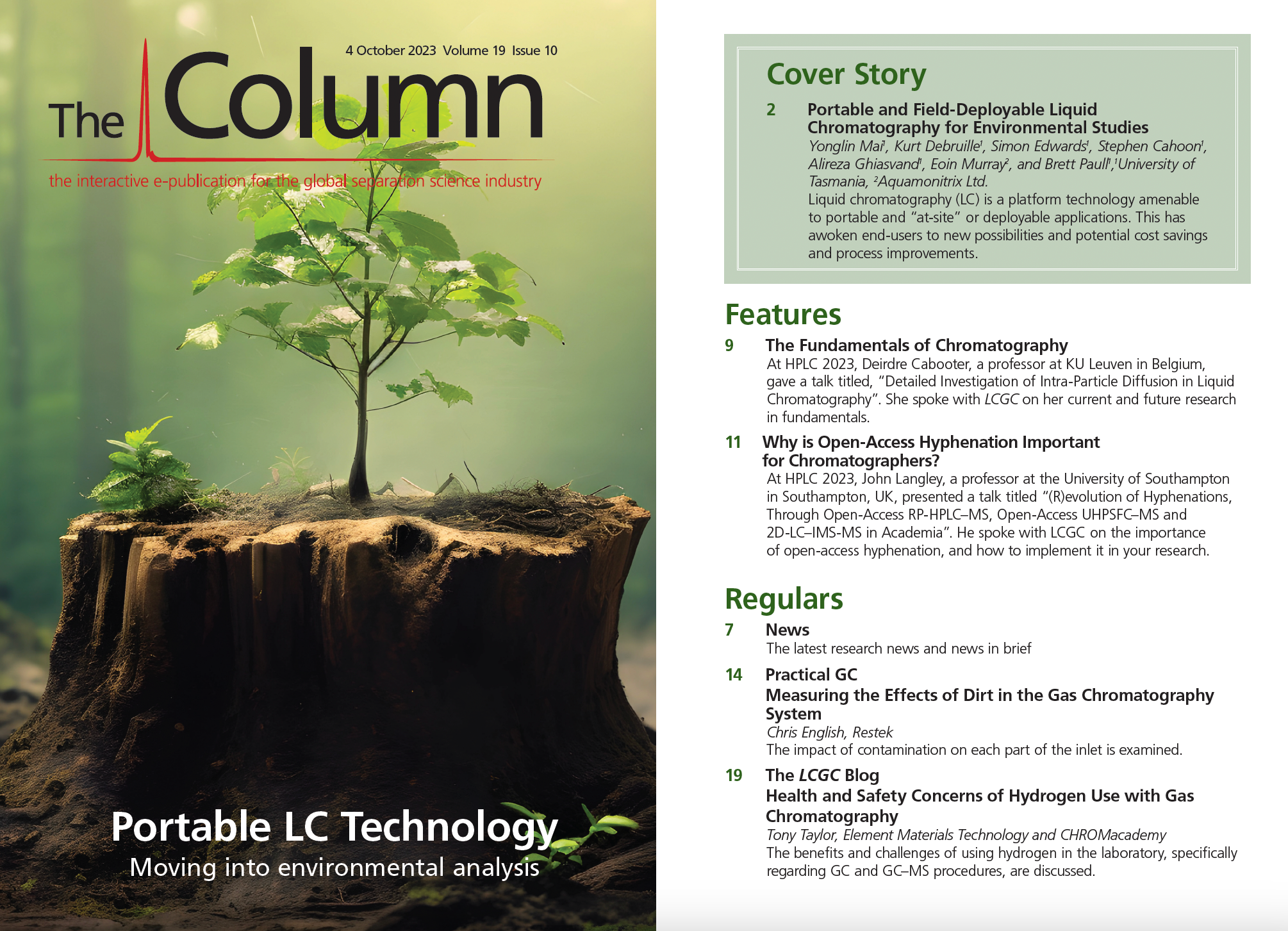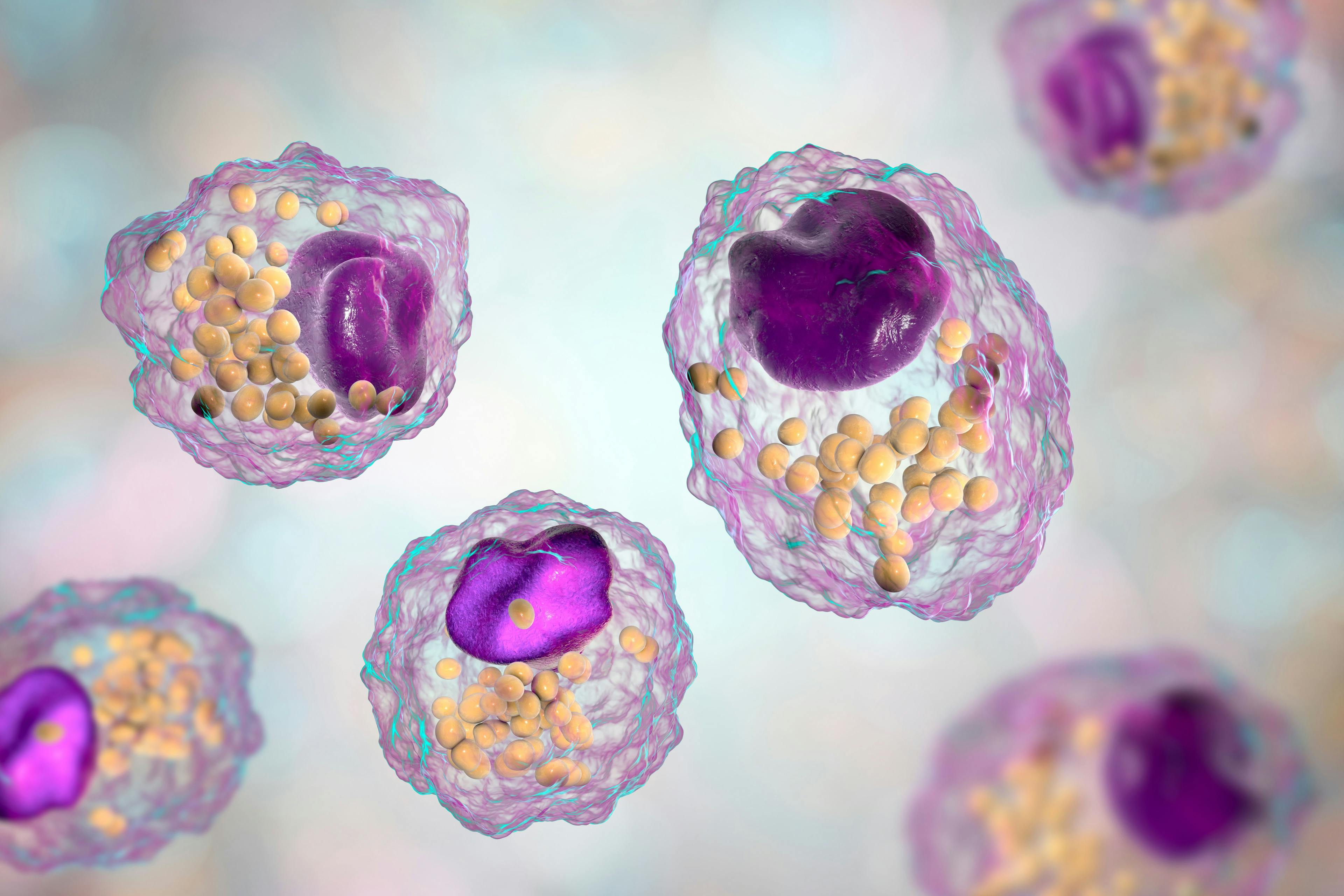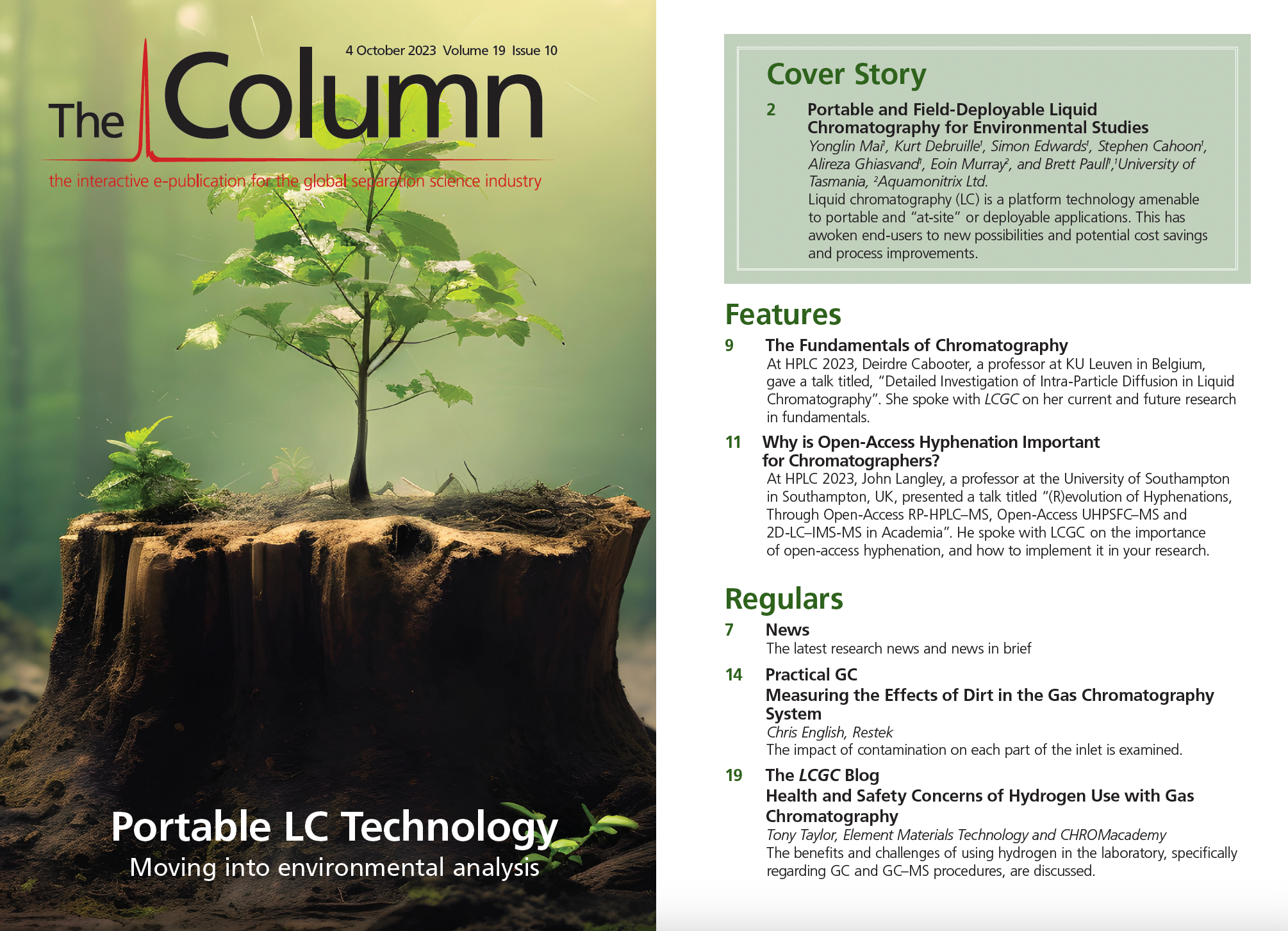Portable and Field‑Deployable Liquid Chromatography for Environmental Studies
Liquid chromatography (LC) is a platform technology amenable to portable and “at-site” or deployable applications. This has awoken end-users to new possibilities and potential cost savings and process improvements.
In all areas of analytical chemistry there are obvious advantages to be gained in being able to undertake the analysis at the point of interest or need, and this is particularly so for environmental analysis. Field-portable and long-term “deployable” chromatography systems can provide for robust at-site analysis (monitoring), allow for rapid on‑site decision making, and reduce issues arising from sample degradation and/or contamination during transportation back to the laboratory, or during long‑term sample storage. Further to this, there are significant financial savings to be had, as laboratory analyses are for the most part clearly more expensive.
The significance of liquid chromatography (LC) as a gold standard analytical technique within the analytical laboratory cannot be under-estimated, with this advanced and well‑established analytical technology being the go-to technique for all sorts of investigative and confirmatory analytical science, across a hugely diverse range of disciplines and applications. However, translation of the standard liquid chromatograph to a mobile, portable, and even deployable instrument has been curiously slow, that is until now. Today, there are a number of small‑footprint LC‑based systems commercially available, which are designed for portability, and interest in these systems has been growing rapidly (1–7).
Milton Lee and co-workers led this most recent charge in and around 2014, reporting on portable nano-flow LC systems, which were shown to deliver impressive performance (8–10). Their first prototype was based on an isocratic piston pump, with stop-flow injection, capillary column, and on‑capillary UV absorbance detector. In 2015, Sharma et al. reported upon a more advanced version of their previous system, which now included gradient-nanoflow dual‑pumps and an on-capillary deep‑UV‑LED-based detector (9). The pumps were able to operate up to an impressive 550 bar, covering flow rates of 0.5 to 10 μL/min. The dimensions of this system were 31 × 18 × 14 cm and it weighed a mere 8.0 kg—it could also be battery operated. It was later applied to several “in-field” applications, including illicit drug analysis (10).
Running parallel to the above developments is an ongoing project focused on a more modular approach to portable liquid chromatography, initiating from early work by Li et al., and involving a prototype open-platform LC with micro‑syringe pumps capable of simple gradient programs (11). The first micro‑LC was built using micro-syringe pumps (20 μL volume), mini‑switching valves, and a manual injector all assembled on a breadboard, and used a commercial reversed-phase monolithic capillary column, with on-capillary deep‑UV‑LED absorbance detection. The dimensions were just 25 × 25 cm, and it weighed in at just 1.3 kg. This system was further developed by Lam et al., with modifications including a Z-cell-based LED detector, column heater, and an automated injector. This chromatograph weighed ~ 2.7 kg, and in this version all components were contained within a compact 3D-printed portable housing. This upgraded version was lightweight, small-size, and was demonstrated for the in-field analysis of plant extracts (12). A fully modular and re-engineered descendant of these earlier platforms was produced in 2020 (13). This full gradient capillary system (dimensions now of 30 × 45 × 12 cm and 7.2 kg weight) consisted of two syringe solvent pumps capable of handling up to 330 bar across flow rates of 1 to 100 μL/min, with retention time precision of < 1% relative standard deviation (RSD). This instrument now included custom-built software and came with an open architecture design and a flexible configuration to fit a variety of intended on-site applications.
In the area of inorganic ion analysis, the standard laboratory (chromatographic) approach would be to use ion chromatography (IC), most commonly with suppressed conductivity detection. This now long-established methodology is the gold standard analytical technique for inorganic anions and cations, and is likely to remain so for the considerable future—particularly for the analysis of natural and potable waters. Interestingly, so-called portable ion chromatographs were commercially available as far back as the early 1980s, although they did not generate a great deal of attention or application at that time. However, following a hiatus of three or so decades, there are today at least three commercial suppliers of truly field-portable ion chromatographs, engineered from the ground up to be applied out of the laboratory and operate effectively at the point of need (14–16).
One area where field-deployable ion chromatography has a great deal of potential is in the field of nutrient monitoring. Inorganic nutrients—including those most monitored species, namely ammonia, nitrite/nitrate, and phosphate—are of course the lead culprits in freshwater eutrophication. Today, almost every environmental monitoring organization around the globe routinely check for these species, predominantly via costly and slow grab‑sampling and lab-based analysis. For us, portable, low-cost, and low-pressure ion chromatography, including the push for “at-site” and long-term deployable systems, has been a focus of our research efforts dating back over two decades (17), but the last few years has seen this idea really take off, and nowadays affordable commercial systems are available for precisely these applications (16). Recently, to test the robustness and reliability of one such field-deployable ion chromatograph under extreme environmental conditions, we set up a simple monitoring experiment within a greenhouse, in the Australian (Tasmanian) springtime, where ambient conditions can vary from between 4 to 40 °C. The experiment involved a field-portable ion chromatography-based system, which employs direct UV absorbance detection for nitrite and nitrate quantification, and is a fully automated and wirelessly monitored system, capable of unmanned deployment for several months at a time (16). With a model sample system in place consisting of a large, filled water tank, containing a bottom layer of sheep‑manure (ammonia source) covered by a layer of soil and a top layer of sand, the system was set to monitor the production and equilibrium of nitrite and nitrate concentrations over a period of several weeks. Figure 1(a–b) shows the system in place within the greenhouse and the analytical data generated from this controlled field demonstration. The temperature plot demonstrates the daily extremes of temperature, whilst the rapid growth of nitrate and slower continual rise of nitrite levels in the water tank can be continually monitored. Given the number of sample chromatograms run during this deployment, it’s not difficult to see the savings in laboratory time and costs, when compared with taking grab‑samples run on an ion chromatography system within a centralized laboratory.

Of course, the ultimate test of an analytical system’s portability is taking it on a sampling journey! Figure 1(c) really demonstrates this new philosophy and capability. With a fully portable and battery‑powered ion chromatograph, we are able to undertake river cruises and map nutrient levels as we go (and simultaneously enjoy some of our state’s most scenic and evidently unpolluted waterways), which for a chromatography‑based analyzer is really quite something. The benefit here is improved spatial coverage and mapping of dynamic systems, particularly inputs and temporally variable point sources, which can lead to better understanding and management of river catchments in the future.
In summary, it would seem clear that a number of instrument manufacturers and innovators have begun to see liquid chromatography as a platform technology that is indeed amenable to portable and “at-site” or deployable applications. This has awoken end users to new possibilities and potential cost savings and process improvements. We certainly foresee a continuation in this direction and more systems coming to the market—hopefully with inherent flexibility and modularity to allow greater application to really interesting “out-of-lab” challenges.
Acknowledgements
Grant funding from the Australian Research Council gratefully acknowledged (Linkage Grant - LP200200394).
References
(1) Rahimi, F.; Chatzimichail, S.; Saifuddin, A.; et al. A Review of Portable High-Performance Liquid Chromatography: The Future of the Field? Chromatographia 2020, 83, 1165–1195. DOI: 10.1007/s10337-020-03944-6
(2) Vasconcelos Soares Maciel, E.; de Toffoli, A. L.; Sobieski, E.; Domingues Nazário, C. E.; Lanças, F. M. Miniaturized Liquid Chromatography Focusing on Analytical Columns and Mass Spectrometry: A Review. Anal. Chim. Acta 2020, 1103, 11–31. DOI: 10.1016/j.aca.2019.12.064
(3) Mejía-Carmona, K.; Soares da Silva Burato, J.; Borsatto, J. V. B.; de Toffoli, A. L.; Lanças, F. M. Miniaturized Liquid Chromatography Applied to the Analysis of Residues and Contaminants in Food: A Review. TrAC Trends Anal. Chem. 2020, 122, 115735. DOI: 10.1002/elps.202000019
(4) Vargas Medina, D. A.; Maciel, E. V. S.; Lanças, F. M. Miniaturization of Liquid Chromatography Coupled to Mass Spectrometry. 3. Achievements on Chip-Based LC–MS Devices. TrAC Trends Anal. Chem. 2020, 131, 116003. DOI: 10.1016/j.trac.2020.116003
(5) Vargas Medina, D. A.; Maciel, E. V. S.; de Toffoli, A. L.; Lanças, F. M. Miniaturization of Liquid Chromatography Coupled to Mass Spectrometry.: 2. Achievements on Modern Instrumentation for Miniaturized Liquid Chromatography Coupled to Mass Spectrometry. TrAC Trends Anal. Chem. 2020, 128, 115910. DOI: 10.1016/j.trac.2020.115910
(6) Sharma, S.; Plistil, A.; Simpson, R. S.; et al. Instrumentation for Hand-Portable Liquid Chromatography. J. Chromatogr. A 2014, 1327, 80–89. DOI: 10.1016/j.chroma.2013.12.059
(7) Murray, E.; Roche, P.; Briet, M.; et al. Fully Automated, Low-Cost Ion Chromatography System for In-Situ Analysis of Nitrite and Nitrate in Natural Waters. Talanta 2020, 216, 120955. DOI: 10.1016/j.talanta.2020.120955
(8) Sharma, S.; Tolley, L. T.; Tolley, H. D.; et al. Hand-Portable Liquid Chromatographic Instrumentation. J. Chromatogr. A 2015, 1421, 38–47. DOI: 10.1016/j.chroma.2015.07.119
(9) Zhao, X.; Xie, X.; Sharma, S.; et al. Compact Ultrahigh-Pressure Nanoflow Capillary Liquid Chromatograph. Anal. Chem. 2017, 89, 807– 812. DOI: 10.1021/acs.analchem.6b03575
(10) Foster, S. W.; Xie, X.; Pham, M.; et al. Portable Capillary Liquid Chromatography for Pharmaceutical and Illicit Drug Analysis. J. Sep. Sci. 2020, 43, 1623–1627. DOI: 10.1002/jssc.201901276
(11) Li, Y.; Dvořák, M.; Nesterenko, P. N.; et al. Miniaturised Medium Pressure Capillary Liquid Chromatography System with Flexible Open Platform Design Using Off-the-Shelf Microfluidic Components. Anal. Chim. Acta 2015, 896, 166–176. DOI: 10.1016/j.aca.2015.09.015
(12) Lam, S. C.; Coates, L. J.; Hemida, M.; et al. Miniature and Fully Portable Gradient Capillary Liquid Chromatograph. Anal. Chim. Acta 2020, 1101, 199–210. DOI: 10.1016/j.aca.2019.12.014
(13) Coates, L. J.; Lam, S. C.; Gooley, A. A.; et al. Modular, Cost-Effective, and Portable Capillary Gradient Liquid Chromatography System for On-Site Analysis. J. Chromatogr. A 2020, 1626, 461374. DOI: 10.1016/j.chroma.2020.461374
(14) Ion chromatograph LPIC-A10. www.labtron.com/portable-ion-chromatograph/lpic-a10 (accessed 2022-10-25).
(15) Shine – Portable ion chromatograph. www.dksh.com/global-en/products/ins/shine-portable-ion-chromatograph (accessed 2022- 10-25).
(16) Aquamonitrix real-time nitrate and nitrite analyser. https://aquamonitrix.com (accessed 2022-10-25).
(17) Victory, D.; Nesterenko, P.; Paull, B. Low-Pressure Gradient Micro-Ion Chromatography With Ultra-Short Monolithic Anion Exchange Column. The Analyst 2004, 129, 700–701. DOI: 10.1039/B407483A
Yonglin Mai is a second-year PhD student at the University of Tasmania.
Kurt Debruille is a first-year PhD student at the University of Tasmania.
Simon Edwards is a research engineer at Sense-T within the University of Tasmania.
Stephen Cahoon is the director of Sense-T at the University of Tasmania.
Alireza Ghiasvand is an adjunct senior lecturer within the School of Natural Sciences – Chemistry at the University of Tasmania.
Eoin Murray is R&D manager for Aquamonitrix Ltd., Carlow, Ireland.
Brett Paull is professor of analytical chemistry at the University of Tasmania, and director of the ARC Training Centre for Hyphenated Analytical Separation Technologies (HyTECH). Email: brett.paull@utas.edu.au

Polysorbate Quantification and Degradation Analysis via LC and Charged Aerosol Detection
April 9th 2025Scientists from ThermoFisher Scientific published a review article in the Journal of Chromatography A that provided an overview of HPLC analysis using charged aerosol detection can help with polysorbate quantification.
Removing Double-Stranded RNA Impurities Using Chromatography
April 8th 2025Researchers from Agency for Science, Technology and Research in Singapore recently published a review article exploring how chromatography can be used to remove double-stranded RNA impurities during mRNA therapeutics production.













